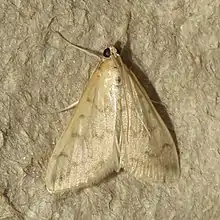| Hahncappsia pergilvalis | |
|---|---|
 | |
| Scientific classification | |
| Domain: | Eukaryota |
| Kingdom: | Animalia |
| Phylum: | Arthropoda |
| Class: | Insecta |
| Order: | Lepidoptera |
| Family: | Crambidae |
| Genus: | Hahncappsia |
| Species: | H. pergilvalis |
| Binomial name | |
| Hahncappsia pergilvalis (Hulst, 1886) | |
| Synonyms | |
| |
Hahncappsia pergilvalis is a moth in the family Crambidae. It was described by George Duryea Hulst in 1886.[1] It is found in North America, where it has been recorded from Ontario and the north-eastern and south-western United States.[2] It is also present in Mexico, where it has been recorded from the Federal District, Puebla and Jalisco.
The wingspan is 20–26 mm.[3] Adults have been recorded on wing from May to September.
References
- ↑ Nuss, M.; et al. (2003–2014). "GlobIZ search". Global Information System on Pyraloidea. Retrieved July 15, 2014.
- ↑ "801445.00 – 4968 – Hahncappsia pergilvalis – (Hulst, 1886)". North American Moth Photographers Group. Mississippi State University. Retrieved August 11, 2019.
- ↑ Proceedings of the United States National Museum 120 (3561)
- ↑ McLeod, Robin (April 12, 2018). "Species Hahncappsia pergilvalis - Hodges#4968". BugGuide. Retrieved August 11, 2019.
This article is issued from Wikipedia. The text is licensed under Creative Commons - Attribution - Sharealike. Additional terms may apply for the media files.